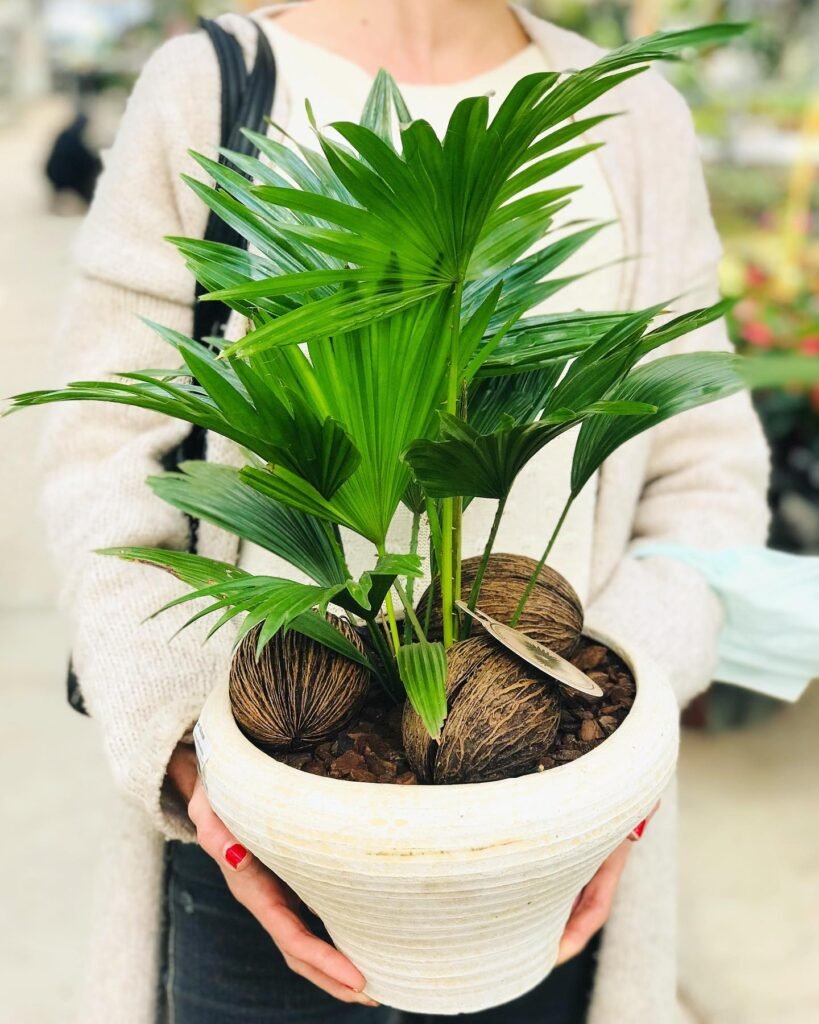Did you know that Livistona rotundifolia, also known as the Livistona Palm, is one of the most sought-after indoor plants in the United Kingdom? Its popularity is on the rise as more people realize the numerous benefits it brings to their living spaces. The Livistona palm is not only a stunning addition with its large, shiny, fan-shaped leaves, but it’s also a low-maintenance plant that can adapt well to indoor living. However, caring for this plant properly is essential to ensure its health and beauty.
Appearance of Livistona rotundifolia (Livistona Palm)
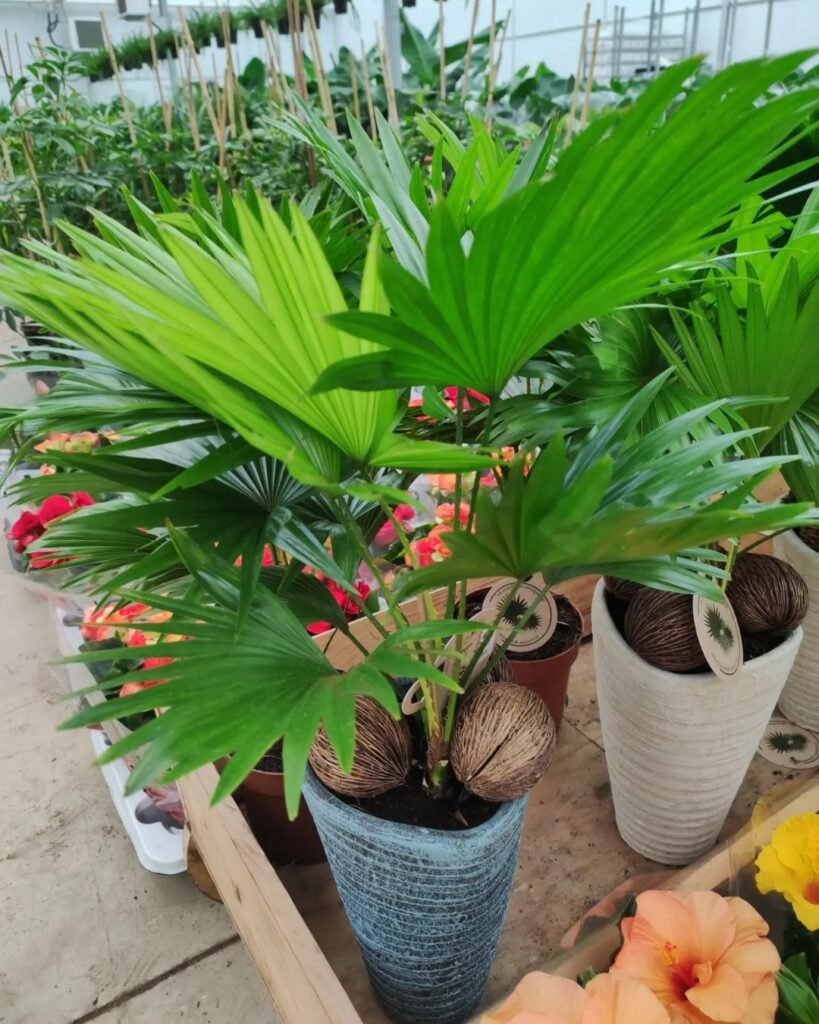

Livistona rotundifolia, also known as Livistona Palm, is a palm species native to South East Asia and New Guinea. It features large, glossy, fan-shaped leaves and thorny stems, adding a touch of tropical beauty to any space. Indoors, it can reach a height of up to 2 meters, although it is generally smaller than other palm species. Outdoors, it gradually grows to a height of 4-8 meters. The slow growth rate of Livistona rotundifolia contributes to its compact size, making it a popular choice for indoor enthusiasts. Its striking appearance, resembling a mini palm tree, brings a sense of lush elegance to your home or office.
 Did you know the Livistona Palm can grow very old, up to 100 years or more? It’s super tough and can handle different places to live, from dry lands to rainy spots. It’s like having a piece of history in your home or garden because it stays with you for so long, making the air cleaner too!
Did you know the Livistona Palm can grow very old, up to 100 years or more? It’s super tough and can handle different places to live, from dry lands to rainy spots. It’s like having a piece of history in your home or garden because it stays with you for so long, making the air cleaner too!
Light Requirements for Livistona rotundifolia

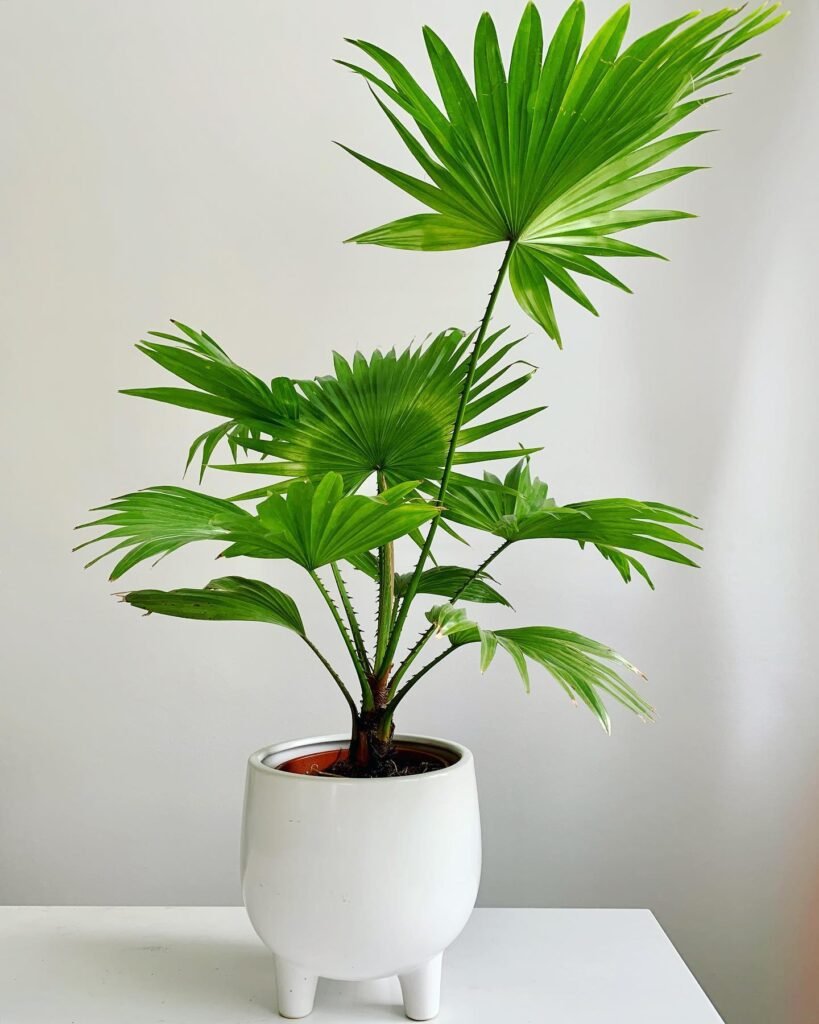
Livistona rotundifolia, known as Livistona Palm, requires bright, indirect light to thrive. It is important to provide the plant with the right amount of light for its optimal growth. While it can tolerate partial shade, direct sunlight should be avoided as it may cause leaf burns or sun damage.
If you are keeping your Livistona rotundifolia indoors, placing it near a north or east-facing window would be ideal. This will allow the plant to receive sufficient light without being exposed to the harsh rays of the sun.
Too much light can be as harmful as too little light for your Livistona rotundifolia. If the plant receives excessive light, the leaves may develop burns or become damaged. On the other hand, insufficient light can result in weak growth and sparse foliage. Striking the right balance and providing the appropriate light conditions are essential for the health and well-being of your Livistona rotundifolia (Livistona Palm).

Watering Tips for Livistona Palm
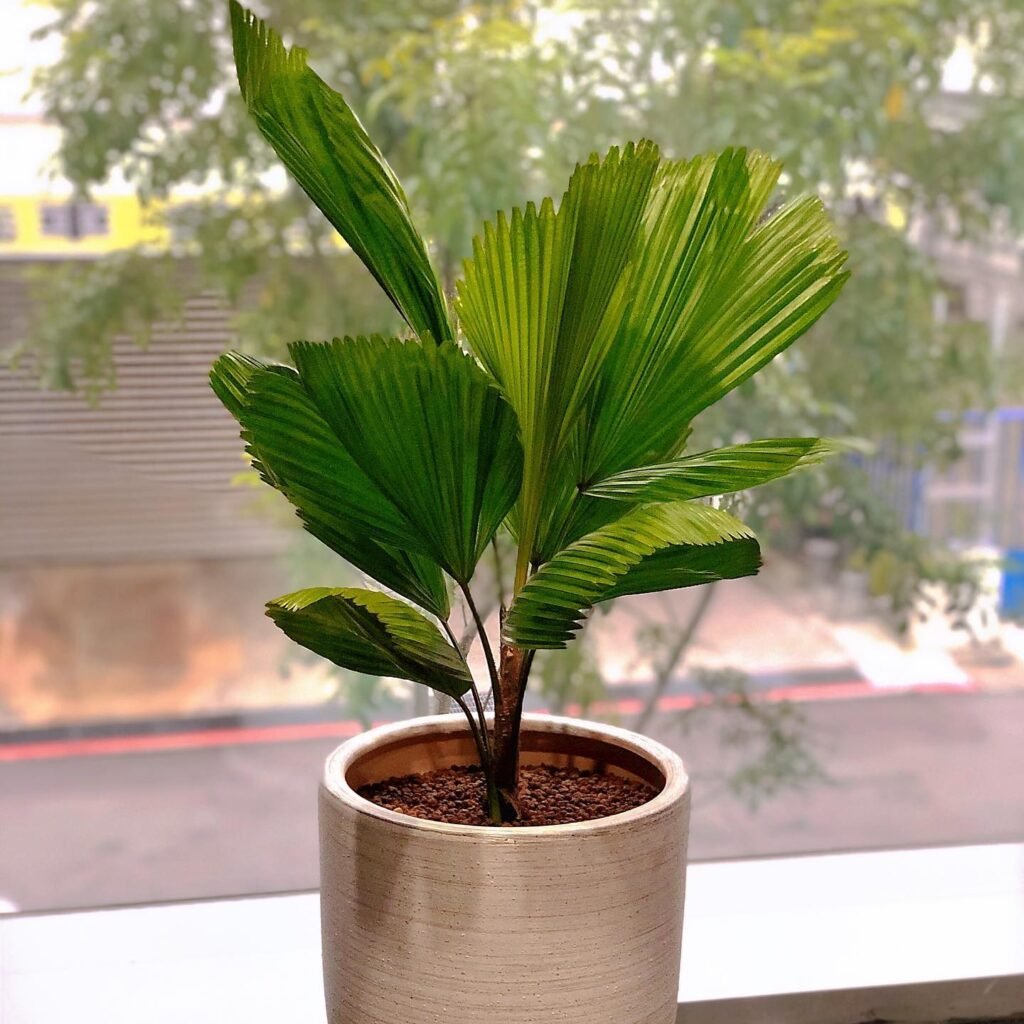

Proper watering is vital for the health and well-being of your Livistona rotundifolia, known as the Livistona Palm. To ensure optimal growth and prevent issues such as root rot and dry leaves, it’s crucial to follow these watering tips:
- Consistent Moisture: Keep the soil consistently moist, but avoid overwatering. Livistona rotundifolia prefers soil that is moist but not waterlogged.
- Allow Drying: Allow the top inch of the soil to dry out slightly between waterings. This helps prevent overwatering and ensures proper drainage.
- Monitor Factors: Take into consideration factors such as humidity levels, temperature, and the size of the pot when determining the frequency of watering. These factors can affect the plant’s water needs.
- Check Moisture Level: Regularly check the moisture level of the soil by sticking your finger about an inch deep into the soil. If it feels dry at this depth, it’s time to water the plant.
Remember, overwatering can lead to root rot and other water-related issues, while underwatering can cause the leaves to dry out and turn brown. Finding the right balance is key to maintaining the health and beauty of your Livistona rotundifolia.

Fertilizing and Soil for Livistona rotundifolia
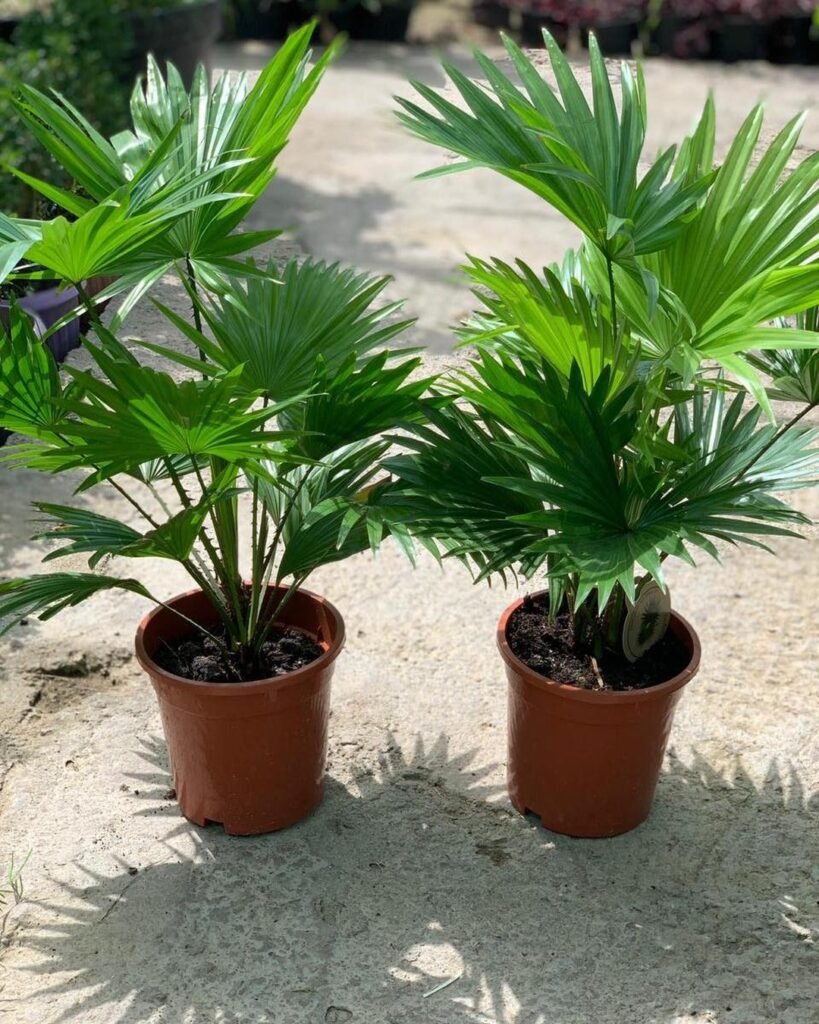
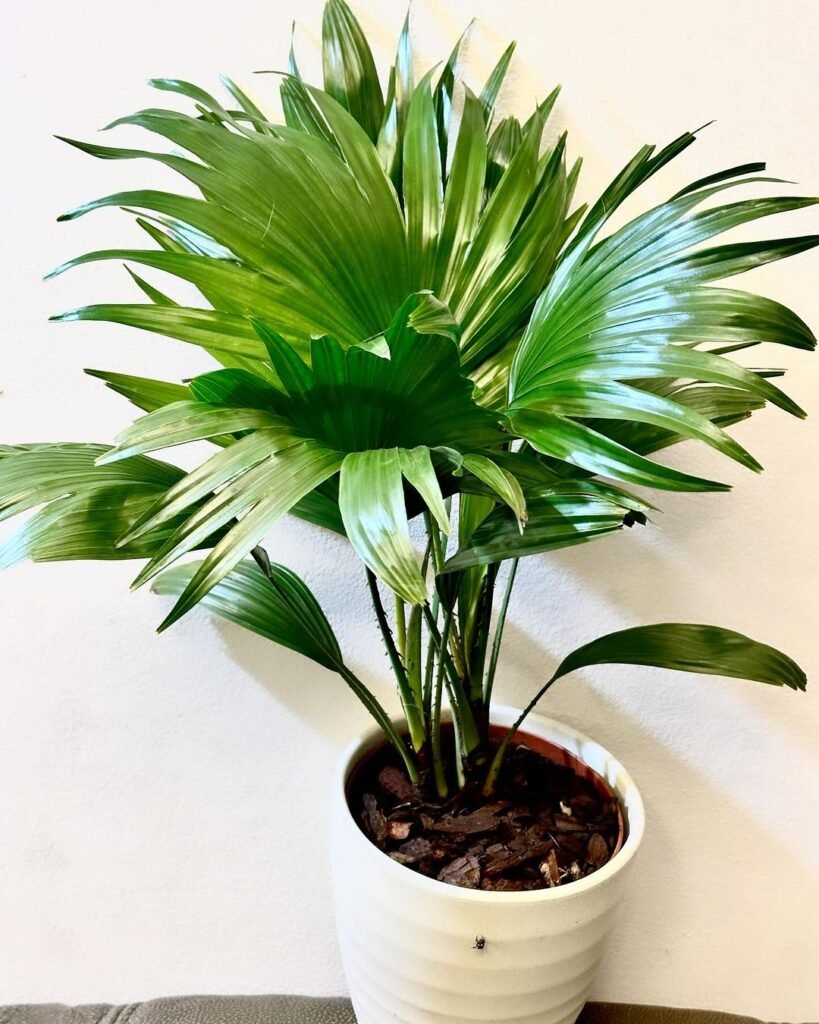
To ensure the health and growth of your Livistona rotundifolia (Livistona Palm), it is important to provide it with the right soil and nutrients. Here are some essential tips on fertilizing and soil requirements for your Livistona rotundifolia:
Soil Requirements
Livistona rotundifolia prefers well-draining soil that retains moisture but does not become waterlogged. It is recommended to use a quality potting mix specifically formulated for palms or tropical plants. This ensures that the soil provides the right balance of nutrients and moisture for optimal growth. Avoid using heavy garden soil or compacted soil, as they can lead to poor drainage and root rot.
Fertilizing Tips
Fertilizing your Livistona rotundifolia during the growing season can supply the plant with essential nutrients for healthy growth. Use a balanced liquid fertilizer labeled for houseplants or palms. Apply the fertilizer every two to four weeks from spring to summer, following the instructions on the packaging for proper dosage and frequency.
Be cautious not to over-fertilize your Livistona rotundifolia, as this can lead to fertilizer burn and damage the plant. It is important to follow the recommended guidelines to avoid any negative effects. Remember, a little goes a long way when it comes to fertilizing your Livistona rotundifolia.
- Use a well-draining soil specifically formulated for palms or tropical plants.
- Avoid heavy garden soil or compacted soil to prevent poor drainage and root rot.
- Apply a balanced liquid fertilizer labeled for houseplants or palms every two to four weeks from spring to summer.
- Follow the instructions on the fertilizer packaging for proper dosage and frequency.

Pruning and Maintenance for Livistona rotundifolia

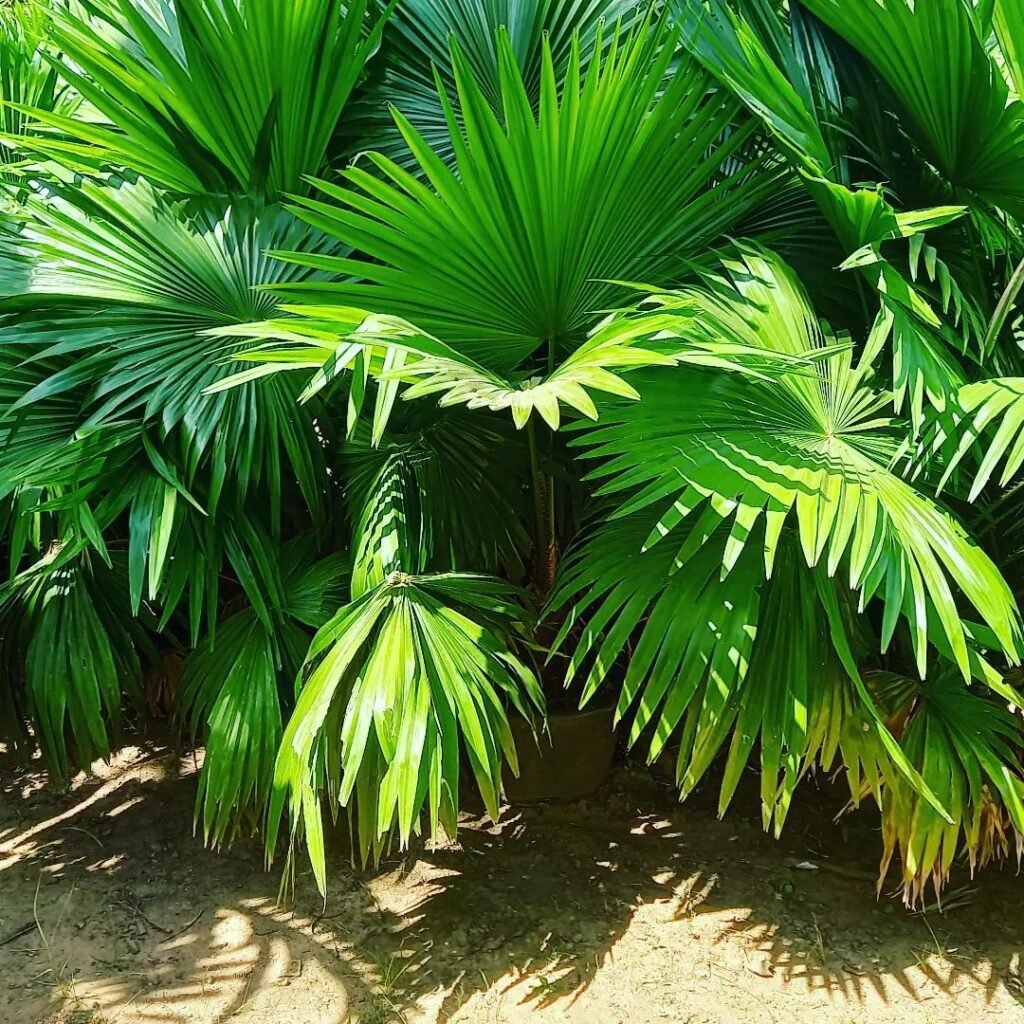
Pruning is not usually required for Livistona rotundifolia unless there are specific reasons such as removing dead or yellowed leaves. Trim off any brown or damaged fronds using clean and sharp pruning tools.
Regular maintenance includes dusting the leaves with a soft cloth or using a gentle spray of water to keep them clean and free from dust. It is important to handle the plant with care as the thorns on the stems can be sharp.
Regularly inspect the plant for any signs of pests or diseases and take appropriate measures to address them.

Propagating Livistona rotundifolia (Livistona Palm)
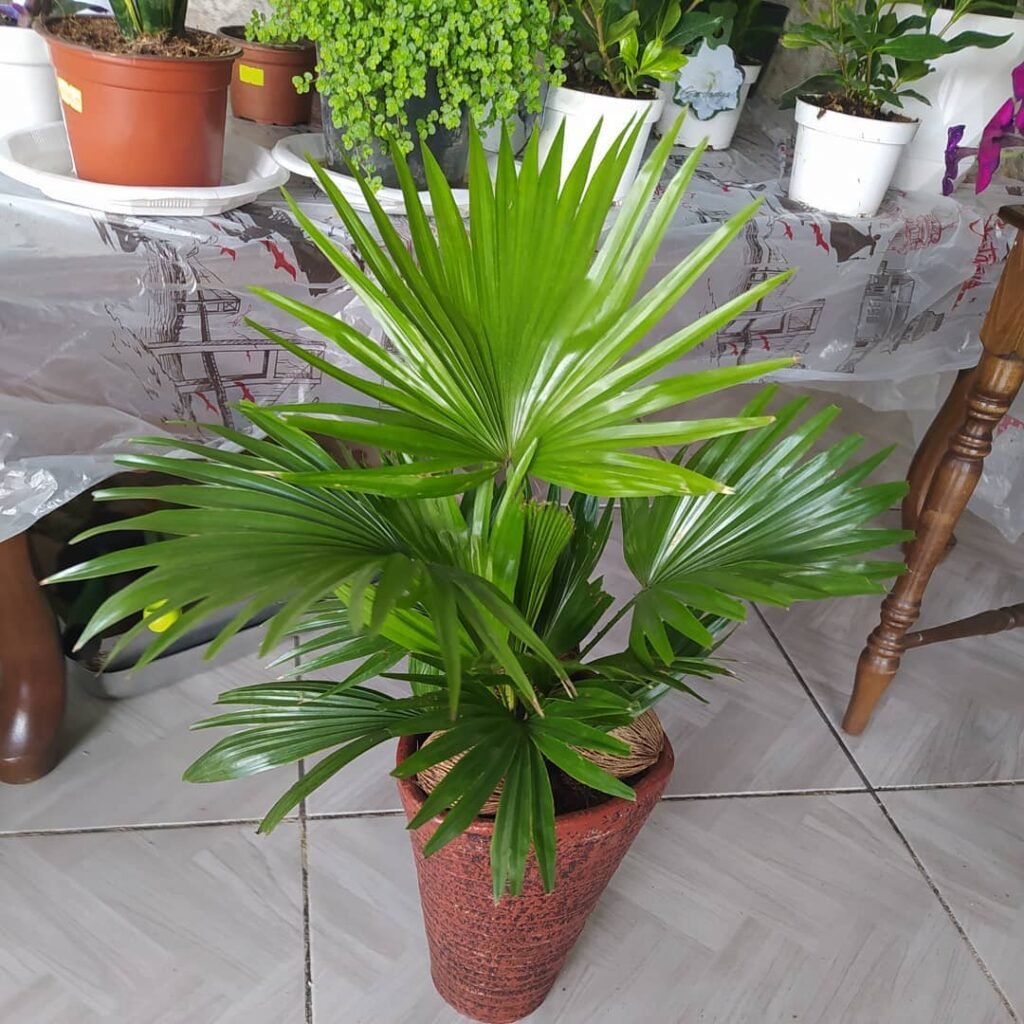
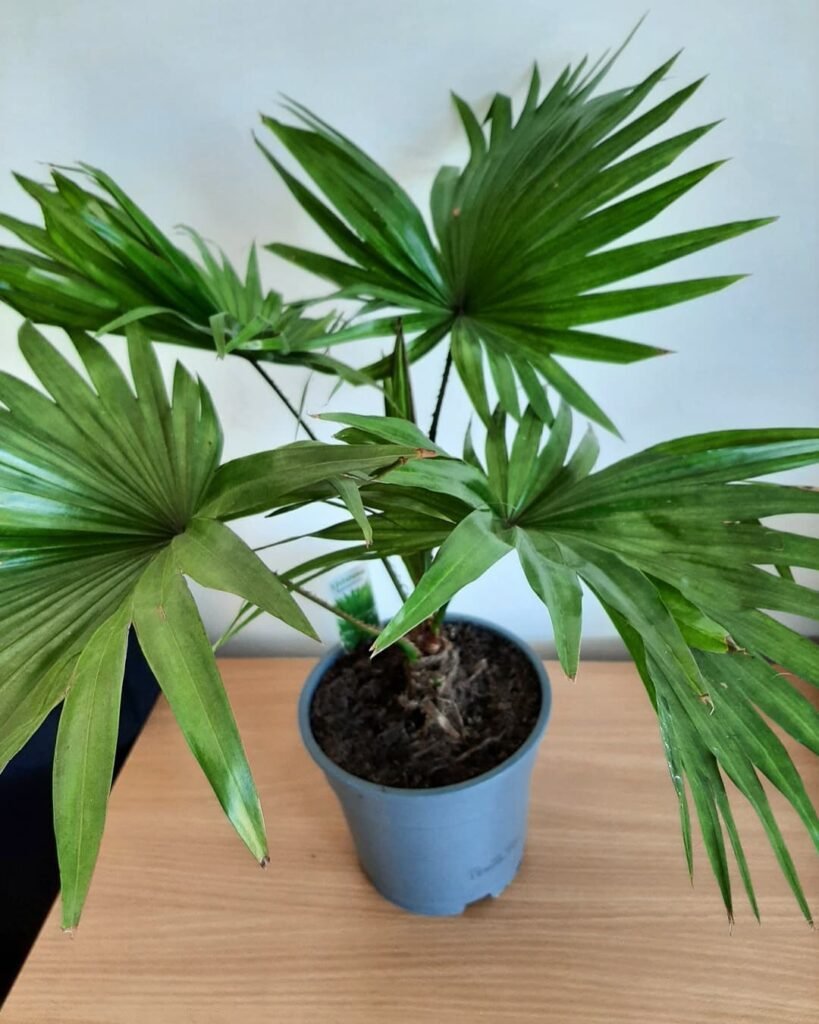
One of the ways to propagate Livistona rotundifolia, also known as the Livistona Palm, is through seed propagation. To begin, collect ripe seeds from mature fruits of the Livistona rotundifolia plant. These seeds can then be planted in a well-draining potting mix. It is important to ensure that the soil is consistently moist throughout the germination process. To provide optimal conditions for germination, maintain a temperature between 25-30°C.
Germination of Livistona rotundifolia seeds may take several weeks to a few months, so patience is required during this process. Once the seedlings have developed a few leaves, they can be carefully transplanted into individual pots. It’s worth noting that seed propagation can be a slow method, but it allows for the satisfaction of growing the plant from its earliest stage.
Alternatively, if you prefer a more immediate option, you can purchase established Livistona rotundifolia plants from nurseries or online suppliers. This eliminates the need for germination and gives you a head start in growing your Livistona Palm.

Repotting Tips for Livistona rotundifolia
Repotting Livistona rotundifolia is an essential task to ensure the healthy growth of your Livistona palm. While repotting is not required every year, it should be done when the plant has outgrown its current pot. Here are some helpful tips to guide you through the repotting process:
- Choose the right time: Spring is the best time to repot your Livistona rotundifolia as the plant is actively growing. This will allow it to adjust to its new pot and growing environment more easily.
- Select the appropriate pot size: Choose a pot that is slightly larger than the current one to provide enough room for the plant’s roots to expand. This will promote healthy growth and prevent the plant from becoming root-bound.
- Use well-draining potting mix: Livistona rotundifolia prefers a well-draining potting mix to avoid waterlogging, which can lead to root rot. A mix specifically formulated for palms or tropical plants is recommended.
- Ensure proper drainage: The new pot should have drainage holes to allow excess water to escape. This will prevent water from pooling at the bottom of the pot and causing root problems.
- Gently remove the plant from its current pot: Carefully loosen the soil and gently lift the plant out of its current pot, being cautious not to damage the roots. If the plant is root-bound, you can gently tease the roots apart to encourage new growth.
- Place the plant in the new pot: Position the Livistona rotundifolia in the center of the new pot and fill in the gaps with fresh potting mix. Firmly press the soil around the roots to ensure stability.
- Water thoroughly: After repotting, water the plant thoroughly to help settle the soil and hydrate the roots. Allow excess water to drain out of the pot, ensuring the plant is not left sitting in water.
Livistona rotundifolia as an Air-purifying Plant
Livistona rotundifolia, known as the Livistona Palm, is not only a visually appealing houseplant but also offers the added benefit of purifying the air in your home. Like other palm species, Livistona rotundifolia has the ability to filter and remove harmful toxins from the surrounding environment, improving the overall indoor air quality. The plant absorbs airborne chemicals and releases oxygen, resulting in a healthier and more refreshing living space.
Having a Livistona rotundifolia in your home can make a significant difference in the air you breathe. It effectively removes pollutants such as formaldehyde, benzene, and xylene, which are commonly found in household products, furniture, and cleaning agents. By incorporating Livistona palms into your indoor environment, you can create a cleaner and fresher atmosphere for you and your loved ones.
Studies have shown that the presence of indoor plants, including Livistona rotundifolia, can decrease the levels of indoor air pollutants and reduce symptoms related to poor air quality, such as headaches, fatigue, and respiratory issues. The plant’s ability to oxygenate the air can also promote a better night’s sleep and enhance overall well-being.
To maximize the air-purifying benefits of your Livistona rotundifolia, it is recommended to have one plant per 100 square feet of living space. This will ensure optimal air filtration and purification. Additionally, regular care and maintenance, such as dusting the leaves and ensuring proper watering and lighting conditions, will support the plant’s overall health and air-purifying abilities.
Incorporating Livistona rotundifolia into your indoor environment not only adds beauty and tropical vibes but also contributes to a healthier living space. Enjoy the numerous benefits of this versatile and air-purifying plant by welcoming a Livistona palm into your home today.
 The Livistona Palm, with its unique round, fan-shaped leaves, is a standout from Asia and Australia. It’s easy to care for, making it popular with gardeners and great for indoor air quality too.
The Livistona Palm, with its unique round, fan-shaped leaves, is a standout from Asia and Australia. It’s easy to care for, making it popular with gardeners and great for indoor air quality too.
Livistona rotundifolia and Pet Safety
Livistona rotundifolia, also known as the Livistona Palm, is a popular indoor plant that adds a touch of tropical beauty to any home. Many pet owners wonder if this plant is safe for their furry friends. The good news is that Livistona rotundifolia is generally considered pet-safe, making it a suitable choice for households with cats and dogs.
Unlike some other plants that can be toxic to pets, Livistona rotundifolia is non-toxic. This means that if your curious cat or mischievous dog happens to nibble on a leaf or stem, it shouldn’t cause any harm. However, it’s always a good idea to keep a close eye on your pets’ behavior around plants and ensure that they don’t ingest any parts of the Livistona palm.
If you notice any signs of discomfort or unusual behavior in your pet after they’ve come into contact with the Livistona rotundifolia, it’s best to consult a veterinarian for further guidance. While this plant is generally safe, individual pets may have different sensitivities or allergies, so it’s important to take their specific needs into consideration.
Livistona rotundifolia Care in the UK
Livistona rotundifolia, known as the Livistona Palm or the Footstool Palm, is a popular houseplant in the UK. Its adaptability to indoor conditions makes it a favorite among plant enthusiasts. To ensure the well-being of your Livistona palm in the UK’s climate, it is essential to provide the right amount of light, moisture, and temperature.
When it comes to light requirements, the Livistona rotundifolia thrives in bright but indirect light. It is best to position it near a north or east-facing window to avoid direct sunlight, which can scorch its leaves. Outdoors, it can be grown during the summer months, but protection from cold temperatures and frost is necessary.
In terms of watering, it is important to keep the soil consistently moist without overwatering. Allowing the top inch of the soil to dry out slightly between waterings helps prevent root rot. Adjust the watering frequency based on factors like humidity levels and pot size.
Indoor cultivation is generally recommended for year-round care and optimal growth of the Livistona rotundifolia in the UK. However, with proper precautions, it can be enjoyed outdoors during the summer. By providing the right conditions for your Livistona palm, you can ensure its health and beauty as it adds a touch of tropical charm to your home.
Helpful Videos about Livistona rotundifolia (Livistona Palm)
In this handpicked selection, I’ve pulled together some great videos packed with tips for looking after your Livistona rotundifolia, also known as the Livistona Palm. These videos will take you through all the basics you need to keep your palm thriving and healthy, perfect for gardening newbies.
- 5 Tips for Indoor Palm Care
- ‘Livistona palm from morrisons’
FAQ about Growing Livistona rotundifolia (Livistona Palm)

Want to know how to care for your Livistona rotundifolia? Check out my easy-to-follow FAQ for all the best advice on helping your Livistona Palm thrive. From the right amount of light to the best watering practice, I’ve gathered all the essentials you’ll need.
It enjoys bright, indirect light but can tolerate some shade. Avoid direct sunlight that can scorch the leaves.
Water when the topsoil feels dry. Over the winter, water less frequently.
Use a well-draining potting mix. Adding a bit of sand or perlite can improve drainage.
Signs include yellowing or droopy leaves. Let the soil dry out a bit more between waterings.
It prefers temperatures between 16-27°C. Keep it away from draughts and cold windows.
Indoors, it can reach up to 2-3 meters. Its growth is limited by pot size and pruning.
Yes, it enjoys humidity. Misting the leaves regularly helps mimic its natural environment.
Only to remove dead or yellowing leaves. Cut close to the trunk using clean shears.
It’s best kept indoors where you can control the environment, especially during colder months.
Repot every 2-3 years or when it becomes root-bound in its current pot.
Keep an eye out for spider mites and scale insects, especially in dry conditions.
Wipe them down with a damp cloth to remove dust. Don’t use leaf shine products as they can clog pores.
This can be due to low humidity, underwatering, or a build-up of fertilizer salts.
Yes, it’s non-toxic to cats and dogs.
Yes, Livistona Palms are slow growers, especially in less than ideal light and temperature conditions.
Yes, during warm months, you can acclimatize it to a shaded spot outside but bring it in before it gets cold.
It’s unlikely to flower indoors, as it typically requires more sunlight than indoor conditions provide.
I trust this sheds some light on the care of your Livistona rotundifolia. If you’re left wondering about anything, drop your questions in the comments – I’m here to help out. Keep in mind, every green thumb begins with bare soil, and there’s a whole world of fascinating plant knowledge waiting for you to discover.

